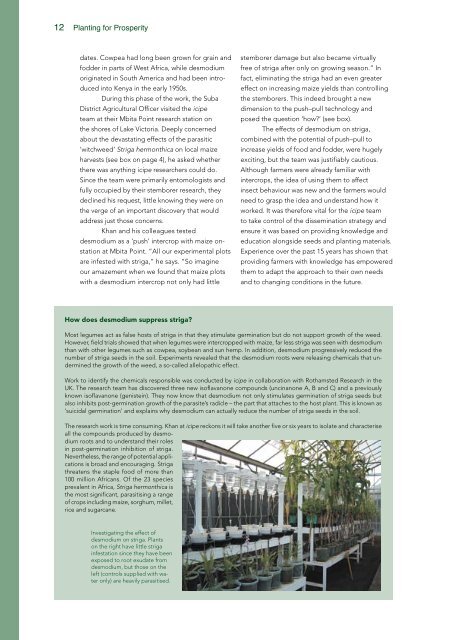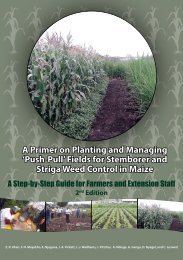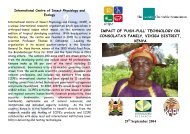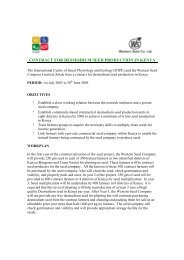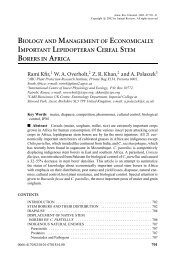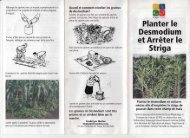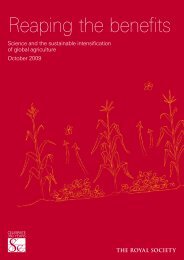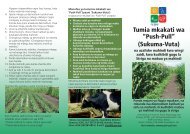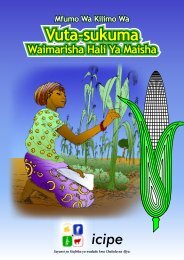a model for Africa's green revolution - Push-Pull
a model for Africa's green revolution - Push-Pull
a model for Africa's green revolution - Push-Pull
You also want an ePaper? Increase the reach of your titles
YUMPU automatically turns print PDFs into web optimized ePapers that Google loves.
12 Planting <strong>for</strong> Prosperity<br />
dates. Cowpea had long been grown <strong>for</strong> grain and<br />
fodder in parts of West Africa, while desmodium<br />
originated in South America and had been introduced<br />
into Kenya in the early 1950s.<br />
During this phase of the work, the Suba<br />
District Agricultural Officer visited the icipe<br />
team at their Mbita Point research station on<br />
the shores of Lake Victoria. Deeply concerned<br />
about the devastating effects of the parasitic<br />
‘witchweed’ Striga hermonthica on local maize<br />
harvests (see box on page 4), he asked whether<br />
there was anything icipe researchers could do.<br />
Since the team were primarily entomologists and<br />
fully occupied by their stemborer research, they<br />
declined his request, little knowing they were on<br />
the verge of an important discovery that would<br />
address just those concerns.<br />
Khan and his colleagues tested<br />
desmodium as a ‘push’ intercrop with maize onstation<br />
at Mbita Point. “All our experimental plots<br />
are infested with striga,” he says. “So imagine<br />
our amazement when we found that maize plots<br />
with a desmodium intercrop not only had little<br />
stemborer damage but also became virtually<br />
free of striga after only on growing season.” In<br />
fact, eliminating the striga had an even greater<br />
effect on increasing maize yields than controlling<br />
the stemborers. This indeed brought a new<br />
dimension to the push–pull technology and<br />
posed the question ‘how’ (see box).<br />
The effects of desmodium on striga,<br />
combined with the potential of push–pull to<br />
increase yields of food and fodder, were hugely<br />
exciting, but the team was justifiably cautious.<br />
Although farmers were already familiar with<br />
intercrops, the idea of using them to affect<br />
insect behaviour was new and the farmers would<br />
need to grasp the idea and understand how it<br />
worked. It was there<strong>for</strong>e vital <strong>for</strong> the icipe team<br />
to take control of the dissemination strategy and<br />
ensure it was based on providing knowledge and<br />
education alongside seeds and planting materials.<br />
Experience over the past 15 years has shown that<br />
providing farmers with knowledge has empowered<br />
them to adapt the approach to their own needs<br />
and to changing conditions in the future.<br />
How does desmodium suppress striga<br />
Most legumes act as false hosts of striga in that they stimulate germination but do not support growth of the weed.<br />
However, field trials showed that when legumes were intercropped with maize, far less striga was seen with desmodium<br />
than with other legumes such as cowpea, soybean and sun hemp. In addition, desmodium progressively reduced the<br />
number of striga seeds in the soil. Experiments revealed that the desmodium roots were releasing chemicals that undermined<br />
the growth of the weed, a so-called allelopathic effect.<br />
Work to identify the chemicals responsible was conducted by icipe in collaboration with Rothamsted Research in the<br />
UK. The research team has discovered three new isoflavanone compounds (uncinanone A, B and C) and a previously<br />
known isoflavanone (genistein). They now know that desmodium not only stimulates germination of striga seeds but<br />
also inhibits post-germination growth of the parasite’s radicle – the part that attaches to the host plant. This is known as<br />
‘suicidal germination’ and explains why desmodium can actually reduce the number of striga seeds in the soil.<br />
The research work is time consuming. Khan at icipe reckons it will take another five or six years to isolate and characterise<br />
all the compounds produced by desmodium<br />
roots and to understand their roles<br />
in post-germination inhibition of striga.<br />
Nevertheless, the range of potential applications<br />
is broad and encouraging. Striga<br />
threatens the staple food of more than<br />
100 million Africans. Of the 23 species<br />
prevalent in Africa, Striga hermonthica is<br />
the most significant, parasitising a range<br />
of crops including maize, sorghum, millet,<br />
rice and sugarcane.<br />
Investigating the effect of<br />
desmodium on striga. Plants<br />
on the right have little striga<br />
infestation since they have been<br />
exposed to root exudate from<br />
desmodium, but those on the<br />
left (controls supplied with water<br />
only) are heavily parasitised.


